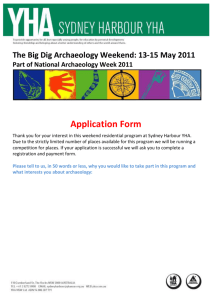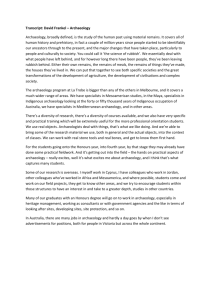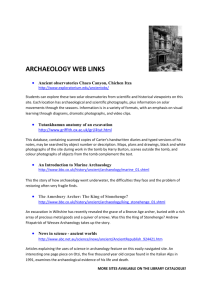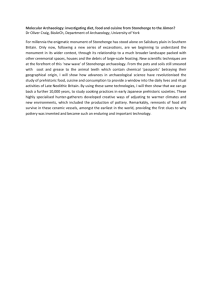file: OT5075 This is a provisional course syllabus. A final draft will be
advertisement
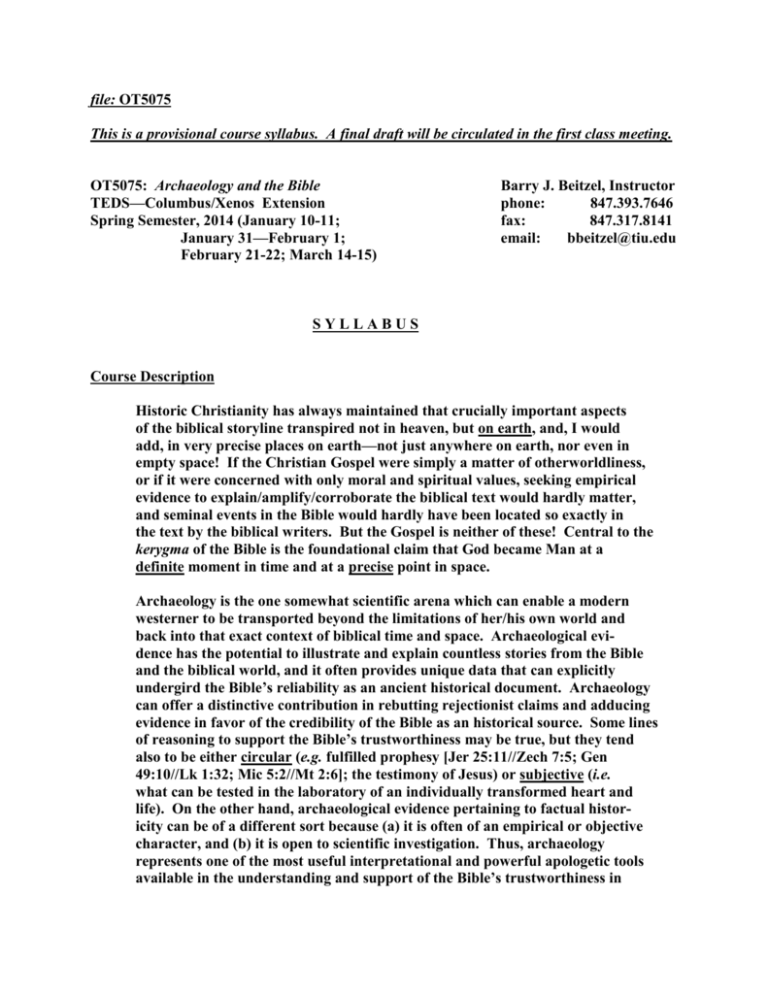
file: OT5075 This is a provisional course syllabus. A final draft will be circulated in the first class meeting. OT5075: Archaeology and the Bible TEDS—Columbus/Xenos Extension Spring Semester, 2014 (January 10-11; January 31—February 1; February 21-22; March 14-15) Barry J. Beitzel, Instructor phone: 847.393.7646 fax: 847.317.8141 email: bbeitzel@tiu.edu SYLLABUS Course Description Historic Christianity has always maintained that crucially important aspects of the biblical storyline transpired not in heaven, but on earth, and, I would add, in very precise places on earth—not just anywhere on earth, nor even in empty space! If the Christian Gospel were simply a matter of otherworldliness, or if it were concerned with only moral and spiritual values, seeking empirical evidence to explain/amplify/corroborate the biblical text would hardly matter, and seminal events in the Bible would hardly have been located so exactly in the text by the biblical writers. But the Gospel is neither of these! Central to the kerygma of the Bible is the foundational claim that God became Man at a definite moment in time and at a precise point in space. Archaeology is the one somewhat scientific arena which can enable a modern westerner to be transported beyond the limitations of her/his own world and back into that exact context of biblical time and space. Archaeological evidence has the potential to illustrate and explain countless stories from the Bible and the biblical world, and it often provides unique data that can explicitly undergird the Bible’s reliability as an ancient historical document. Archaeology can offer a distinctive contribution in rebutting rejectionist claims and adducing evidence in favor of the credibility of the Bible as an historical source. Some lines of reasoning to support the Bible’s trustworthiness may be true, but they tend also to be either circular (e.g. fulfilled prophesy [Jer 25:11//Zech 7:5; Gen 49:10//Lk 1:32; Mic 5:2//Mt 2:6]; the testimony of Jesus) or subjective (i.e. what can be tested in the laboratory of an individually transformed heart and life). On the other hand, archaeological evidence pertaining to factual historicity can be of a different sort because (a) it is often of an empirical or objective character, and (b) it is open to scientific investigation. Thus, archaeology represents one of the most useful interpretational and powerful apologetic tools available in the understanding and support of the Bible’s trustworthiness in today’s world. Course Objectives 1. To gain an understanding of how two very different disciplines—biblical studies, archaeology—forged an alliance in the past 150 years and formed a new discipline: biblical archaeology. 2. To acquire a basic working knowledge of the discipline of biblical archaeology, its principal sites, personalities, and discoveries. 3. To develop a theoretical methodology for addressing what may be conflict between the results of archaeology and the pronouncements of the Bible: to become aware of and to be able to discuss in some detail some of the more contentious issues. 4. To become familiar with the major archaeological finds, and to understand more fully how these may impinge on the Bible. 5. To explore the foundational archaeological bibliography and develop a good sense of what constitutes genuine archaeological research and evidence. 6. To gain an appreciation of the impact archaeology can have on an understanding and interpretation of the biblical storyline. 7. To consider fairly thoroughly how an Evangelical should attempt to integrate archaeology and one’s own belief systems. Course Textbooks (see below) Provisional Course Schedule date January 10-11 January 31— February 1 discussion topics course introduction and overview; fragmentary nature of the evidence; how archaeology can/should be used and how it cannot/should not be used; why the Bible is commonly rejected as a reliable historical source today; archaeology and the “Evangelical enthusiasts,” a brief sketch of archaeology’s historical development; some of the most significant discoveries in the last 150 years; accidental archaeological discoveries; archaeological frauds; archaeological/biblical periodization; anachronism in the Old Testament; biblical characters mentioned by name in the Bible and in ancient secular literature; external annalistic sources referenced in the Old Testament; Old Testament synopticism; consultations on oral presentations archaeology of creation and the flood; archaeology of the biblical patriarchs; archaeology of the Exodus and the wilderness travels; archaeology of the conquest/settlement; archaeological evidence of “Israel” in the 12th century; archaeological evidence of “Israel” in the 10th century; readings Hoffmeier/Millard, pp. 3-42, 357-385; Moorey, pp. 1-175; Mazar, pp. 191-402 Hoerth, pp. 13-295; February 21-22 March 14-15 historicity of David and Solomon; use of radiocarbon dating; consultations on oral presentations archaeology of the Assyrians and Babylonians; archaeology and deportation; archaeology and the Persians; archaeology and repatriations; archaeology and the Greeks; archaeology of the Maccabean rebellion; archaeology of the rise of Jewish sectarianism; archaeology of the Romans; archaeology of the Gospels; archaeology of the Epistles; archaeology of emperor worship and the book of Revelation lingering issues: absence of evidence; credible response when records do not completely comport; how as an Evangelical one should attempt the work of integrating archaeology and one’s own belief systems; oral presentations MacRay, pp. 17-350 Schmidt, pp. 2-195 Grade Determinants 1. Oral presentation (50%)—you are asked to select and research a subject relevant to the subject of archaeology and the Bible, to prepare a 12-page double-spaced termpaper (excluding endnotes and bibliography), and to lead a class discussion of your topic. Use of credible sources, broad characterization of your topic, and demonstration of the relevance of your topic to the Bible will all count heavily in the grade. Your presentation will be given in class on Saturday, March 15. 2. Final examination (30%)—from class readings, and especially from class lectures, you will be asked to write a take-home examination of an essentially essay nature. 3. Reading digest (20%)—you are asked to create a reading digest that condenses the salient points of each reading assignment, to assess each assignment in terms of its out-of-class usefulness, and to critique the assignment with argument and/or content where you think it may be lacking and/or could be helpfully augmented. Coordinator’s note: There are no “required” texts for this course. The study-center (located beneath the main office where our class meets) will have many of the below reference materials available for students to access. The only required readings are the pages above listed in the course schedule. Dr. Beitzel does recommend students at least purchase a copy two texts, one OT archaeology (e.g. Hoerth) and one in NT archaeology (e.g. MacRay). McRay, J., Archaeology and the New Testament. Baker. Hoerth, A., Archaeology and the Old Testament. Baker. Reference Bibliography (selected) 1. Semi-Popular Journals Archaeology Odyssey Bible and Spade Bible Review Biblical Archaeology Review Near Eastern Archaeology Trinity Journal NS 3.2 (1982), pp. 170-194; 4.1 (1983), pp. 44-71; 5.1 (1984), pp. 47-71 2. Monographs Amitai, J., ed., Biblical Archaeology Today. Israel Academy of Sciences. Beitzel, B., The New Moody Atlas of the Bible. Moody/Lion Hudson. Ben-Tor, A., The Archaeology of Ancient Israel. Open University of Israel. Cunliffe, B., ed., Oxford Handbook of Archaeology. Oxford. Currid, J., Doing Archaeology in the Land of the Bible. Baker. Davis, T. , Shifting Sands: the rise and fall of Biblical Archaeology. Oxford. Dever, W., Recent Archaeological Discoveries and Biblical Research. University of Washington. Dever, W., The Lives of Ordinary People in Ancient Israel: When Archaeology and the Bible Intersect. Eerdmans. Finegan, J., The Archaeology of the New Testament. Princeton University. Frank, H., Bible, Archaeology and Faith. Abington. Frend, W., The Archaeology of Early Christianity. Fortress. Freund, R., Digging Through the Bible. Rowman & Littlefield. Fritz, V., An Introduction to Biblical Archaeology. Sheffield. Hoerth, A., Archaeology and the Old Testament. Baker. Hoffmeier, J., The Archaeology of the Bible. Lion Hudson. Hoffmeier, J., and Millard, A., eds., The Future of Biblical Archaeology. Eerdmans. Kenyon, K., The Bible and Recent Archaeology. John Knox. King, P., and Stager, L., Life in Biblical Israel. Westminster. Kitchen, K., On the Reliability of the Old Testament. Eerdmans. Laughlin, J., Archaeology and the Bible. Taylor & Francis. Levy, T., ed., Historical Biblical Archaeology and the Future. Equinox. Magness, J., The Archaeology of the Holy Land. Cambridge. Mansoor, M., A Guide to Biblical Archaeology. University of Wisconsin. Mare, H., The Archaeology of the Jerusalem Area. Baker. Master, D., ed., Oxford Encyclopedia of the Bible and Archaeology. Oxford. Mazar, A., Archaeology of the Land of the Bible – 10,000—586 B.C.E. Doubleday. McRay, J., Archaeology and the New Testament. Baker. Mitchell, T., Biblical Archaeology. Cambridge. Moorey, P., A Century of Biblical Archaeology. Westminster/John Knox. Nakhai, B., Archaeology and the Religions of Canaan and Israel. ASOR. Rast, W., Through the Ages in Palestinian Archaeology. Trinity Press Int’l. Schmidt, B., ed., The Quest for the Historical Israel. SBL. Schoville, K., Biblical Archaeology in Focus. Baker. Silberman, N., and Finkelstein, I., The Bible Unearthed. Touchstone. Thompson, H., Biblical Archaeology. Paragon House. Thompson, J., The Bible and Archaeology. Eerdmans. Tubb, J., Peoples of the Past. British Museum. Tubb, J., and Chapman, R., Archaeology and the Bible. Oxford. Wright, G., Biblical Archaeology. Westminster. 3. Mainstream news articles Time [December 30, 1974] Time [April 10, 1995] U.S. News [April 17, 1995] Time [December 18, 1995] National Geographic [April, 1996] U.S. News [October 25, 1999] National Geographic [January--March, 2000] National Geographic [December, 2008] National Geographic [December, 2010] National Geographic [March, 2012] National Geographic [forthcoming: February 2014]




